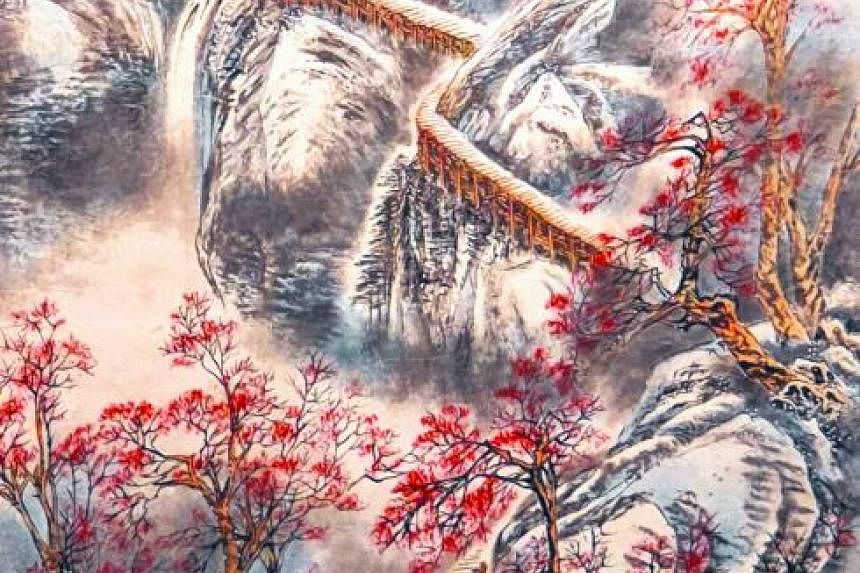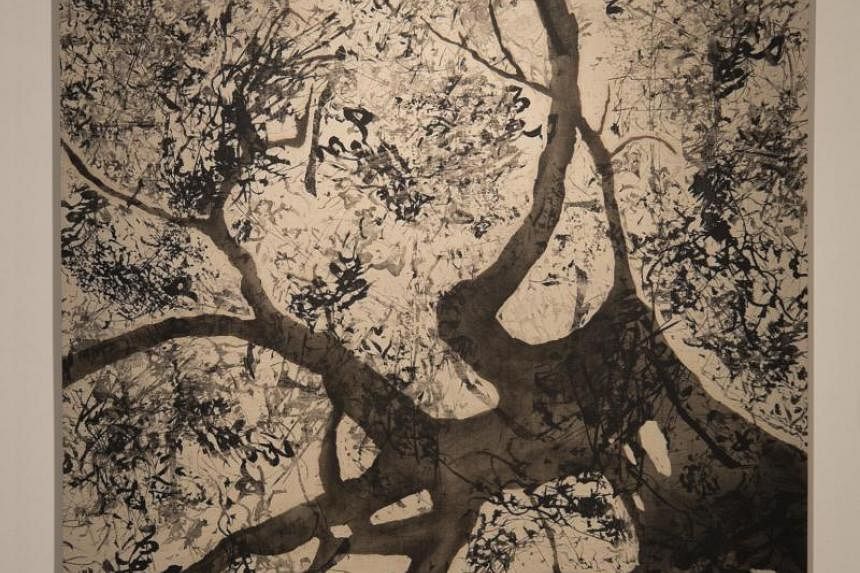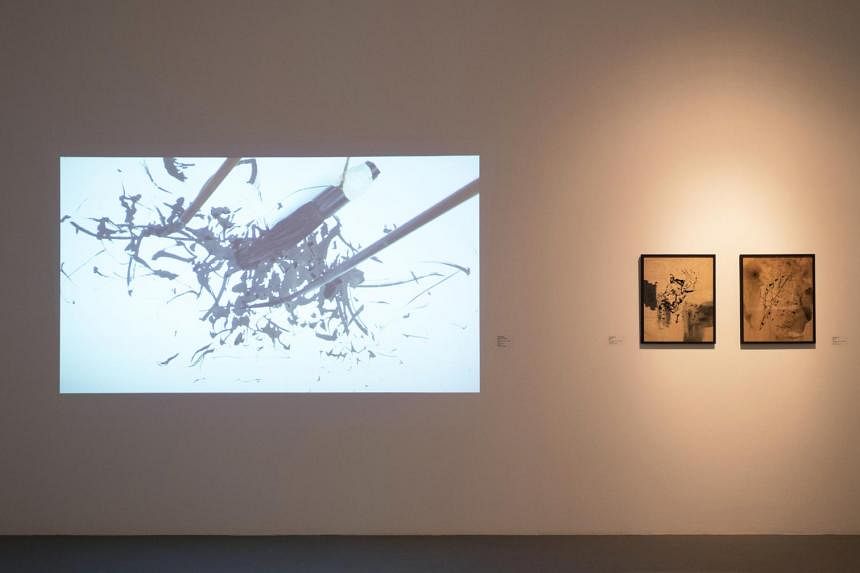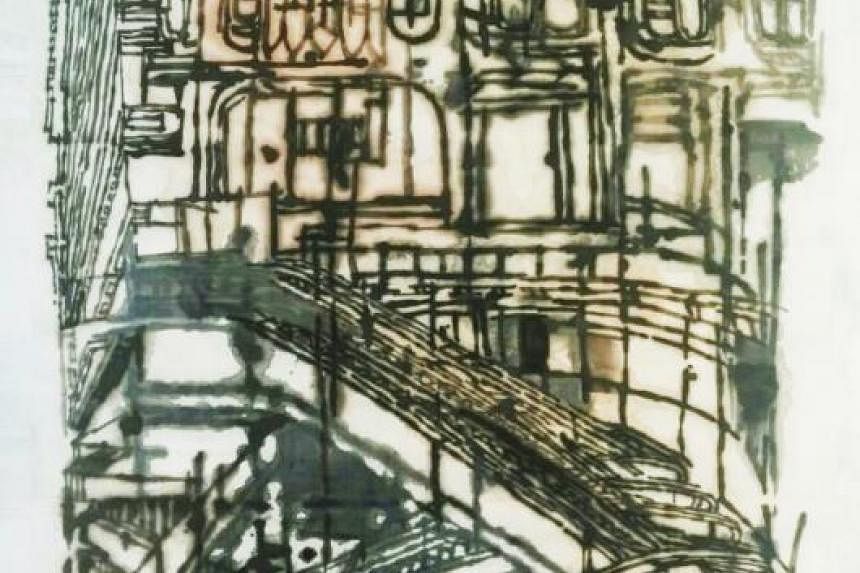The Scholars And Ink exhibition turns on its head the close association of Chinese ink and the traditional Chinese gentry. Common misconceptions about how the medium is used only for traditional calligraphy and classical ink painting are dispelled, as the works provide a modern spin and inject local flavour.
The five artists, all graduates or staff of the National University of Singapore, acknowledge the cultural continuity with the use of ink, but attempt to break free of that tradition.
Where: NUS Museum, 50 Kent Ridge Crescent MRT: Clementi/Kent Ridge When: Till Aug 23, 10am - 7.30pm (Tue - Sat), 10am - 6pm (Sun) Admission: Free Info: community.nus.edu.sg/ cfa/museum/exhibitions.php
Lim Min Zhang
1 SYMPHONY NO. 3 (2008 - 2010)

By Ho Chee Lick, Chinese ink on paper, 225x95cm
The artist sees the brush as not being restricted to the hair and bamboo types. Instead, objects without a clear use in art such as T-shirts and cardboard are used to convey ink to canvas and create texture in the painting. The intensity of the brush marks evokes how a musical piece moves.
2 CITYSCAPE (2015)

By Ling Yang Chang, Chinese ink and colour on paper, 180x145cm
Inspired by a trip to Europe, this work is an urban landscape, but is composed with the idea of a Chinese natural landscape in mind. Mists flow from one corner while the buildings look like mountains.
3 FIRST SNOW AT THE ANCIENT MOUNTAINOUS WOODEN WALKWAYS (1999)

By Tan It Koon, Chinese ink and colour on paper, 134x65.5cm
Tan studied under pioneering artists of the Nanyang style such as Liu Kang and Chen Wen Hsi in the 1950s. This style focuses on mixing Chinese and Western styles in a South-east Asian context. This atmospheric work depicts people carrying tea up to a mountainside inn. The subject matter and composition are very much similar to those of a classical Chinese painting, where mountains ascend and streams descend, with the bridge as a device to lead the viewer through the painting.
4 FREEDOM (2014)

By Yeo Shih Yun, silkscreen on linen, 165x148cm
This artist's works are made "naturally" by hanging multiple brushes on swaying tree branches and letting the brushes make marks on the canvas. Screen prints are made and juxtaposed onto another background to complete the artwork. Yeo acknowledges a debt to British artist Tim Knowles, who first experimented with this technique by attaching pens to willow trees. In this work, the viewer has a bottom-up perspective, looking up to the leaves and branches on top.
5 THE CONVERSATION (2011)

By Yeo Shih Yun, digital video (colour, sound), 10:47min, size variable
One reason Yeo was drawn to Chinese ink is its "historical richness" and "physical strength and boldness". The video shows nature as the painter, with the wind moving the brush. Interspersed with the visuals are the sounds of waves and insects and the occasional construction work at Labrador Park. Examples of the completed work are Freedom, as well as Raw #2 and Raw #1 beside the video, which are silkscreen and ink on glass.
6 NUMERICAL DOTS XVI (2014)

By Ling Yang Chang, Chinese ink and colour on paper, 90x96cm
This is another work that diverges from the traditional way of understanding Chinese ink, which has to follow a certain format and subject matter. But the painting still adheres to fundamental principles of the Chinese ink practice. For example, the principle of division and planning is met because of the harmonious balance, space and depth of the 16 dots. The artist, who is a Chinese Studies graduate, also shows hints of being influenced by Western pop and abstract art.
7 LOTUS POND (2014)
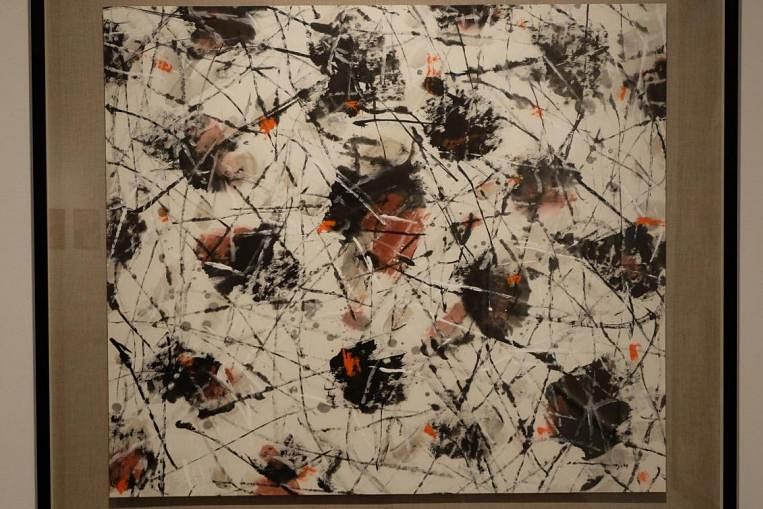
By Ling Yang Chang, Chinese ink and colour on paper, 90x96cm
Lotuses are symbols of purity and peace, and Ling has re-engaged with the subject matter in a bold and abstract fashion. He was inspired by the colourful geometric shapes and semi-abstracted objects in the works of Spanish surrealist painter Joan Miro.
8 WALKING IN THE CITY - PENINSULA PLAZA AND RAFFLES CITY (2012-2015)

By Hong Sek Chern, Chinese ink on paper, 137.5x67.5cm
The artist, a mathematics major, is known for the architectural, dramatic lines in her works. This Escheresque work is a street scene stacked vertically, and requires some unpacking from the viewer of the geometric complexities. For example, are some of the squares construction scaffolding or glass panels? Rather than a "what you see is what you get" perspective in the more traditional mold, this urban landscape requires interpretation from the viewer.


